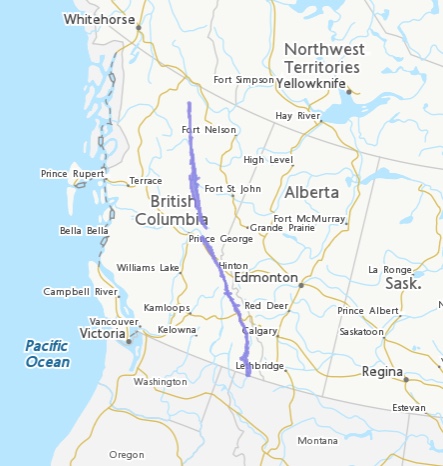British Columbia. Mountain range
From the northernmost part of western Canada to New Mexico in southwestern United States
54.4997 N 122.4997 W
Google —
GeoHack
Earliest known reference to this name is 1752 (Legardeur St. Pierre)
Name officially adopted in 1953
Official in
BC –
Canada
The first travellers called them the Glittering Mountains, on account of the infinite number of immense rock crystals, which, they say, cover their surface, and which, when they are not covered with snow, or in bare places, reflect to an immense distance the rays of the sun. The name Rocky Mountains was given them, probably by later travellers, in consequence of the enormous isolated rocks which they offer here and there to view.
— Gabriel Franchère 1854, quoted in Thorington
The earliest reference to this mountain chain is that of James Knight (c. 1640–c. 1721) , governor of York Factory who, in his diary for 1716, states that Indians had told him that very far to the west there were prodigious mountains so high “they cannot see the tops without it be clear weather.” The first mention of their present name is to be found in Legardeur St. Pierre’s journal for 1752, which refers to the “Montaignes de Roche.”
“Mountains of the bright Stones” on Carver’s map, 1778.
The name of the mountains is a translation of an Amerindian name that is closely related to Algonquian; the Cree name as-sin-wati is given as, “When seen from across the prairies, they looked like a rocky mass”.
The Cree name is Usinnewucheyu, meaning “big rocks” (A Dictionary of the Cree Language, by E.A. Watkins, revised by J.A. Mackay, edited by Richard Faries, 1938). The Sekani name for the Rocky Mountains is Tse Tiy. [meaning/significance and extent not provided] (from Guzagi K’úgé, published by Kaska Tribal Council, Watson Lake, 1997). The Ktunaxa name for the Rocky Mountains is Natmuqc/in, pronounced nath-mook-stin. [meaning/significance and extent not provided] (April 2006 advice from Janice Alpine, Ktunaxa Language Program)
“‘There are no Rocky Mountains’ has been the remark of many a disappointed traveller by the Union or Central Pacific Railways,” wrote George Grant in 1872. “The remark will never be made by those who travel on the Canadian Pacific; there was no ambiguity about these being mountains, nor about where they commenced. The line was defined, and the scarp as clear, as if they had been hewn and chiselled for a fortification. There was nothing fantastic about the mountain forms. Everything was imposing. And these too were ours, an inheritance as precious, if not as plentiful in corn and milk, as the plains they guarded. For mountains elevate the mind, and give an inspiration of courage and dignity to the hardy races who own them and who breathe their atmosphere. We could sympathize with the enthusiast, who returned home after years of absence, and when asked what he had as an equivalent for so much lost time, answered: ‘I have seen the Rocky Mountains.’”
“Rocky Mountains / Montagnes Rocheuses” is among the 75 “Pan-Canadian names,” large and well-known Canadian features and areas designated in Treasury Board Circular 1983-58 to require presentation in both official languages of Canada on federal maps.
